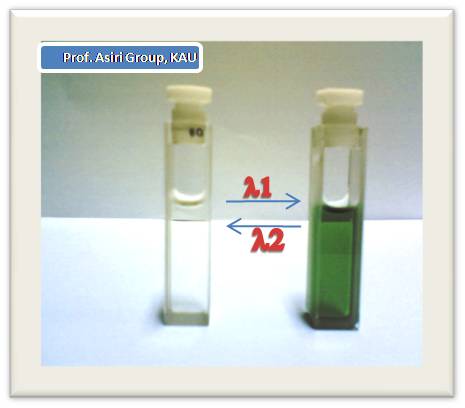Program 2: Organic Materials
i) Synthesis of Organic Switches
This will include the synthesis of novel Photochromic, Thermochromic, Electrochromic, Solvatochromic, Piezochromic and Tribochromic Organic compounds. The Chromism phenomena is based on a switching between two states. The first state has a distinct colour and usually ranging from pale colorless to pale yellow. The second state, after being affected by the external stimuli, shows a remarkable color change and the resulting colors are ranging from orange to deep blue and much more needed to the far end of the visible region or even better to the near infrared region (NIR) region (Figure 1). This program is conducted already in the chemistry department faculty of science, and a group of researchers of post graduate and postdoctoral levels are involved in heavy research in.
The Research group in the above classes is headed by Prof. Asiri and the group had established international links with different research centers (such as the Digital Print Center of industrial collaboration and the department of colour and polymer chemistry at the university of Leeds, headed by Prof. Lin, a well known specialist in the field of anti-counterfeit and security science and technology).
The future work in this theme will cover many aspects of photochromis, thermochromism, solvatochromism and piezochromism. This will include synthesis and characterization of novel compounds and studies of their properties and potential applications.
Research in this unit involve the following:
1- Smart glazing for energy saving in building. 
2- Sensors such as heat, Ultraviolet , Gas sensors,
3- Anti counterfeit in security documents
4- Smart textiles, Smart coating and paints
5- Smart Packaging to detect the exposure of items to unwanted external effects, such as heat or light or radiation.
6- The use of photochromic materials in cosmetic products as UV absorber.
7- Smart plastics, which can change its color on exposure to light and retain its color when the light is taken away for green houses applications.
8- Smart inks, such as photochromic, thermochromic, Piezochromic inks.
The researchers in this theme have many research proposals ready to submit, as an example we have in hand a proposal entitled “ Synthesis and application of photochromic compounds as smart switchable gazing for solar energy and day light control in building “. Which has been approved and funded by KACST in this year cycle. Also the groups are developing new switches for many applications such as chemical sensors.
ii) Materials for Organics Light-Emitting Diodes (OLEDs)
OLEDs are energy conversion devices (electricity-to-light) based on electroluminescence. OLEDs first attracted the attention of researchers in the 1960s because of their potentially high quantum efficiency of luminescence and the ability to generate a wide variety of colors. Unfortunately, their high operating voltages (>1000V) prohibited them from becoming practical devices. However, in 1987, after C. Tang and Van Slyke (5) from Eastman Kodak devised a heterostructure double layered device containing active “small molecules” that combined a low operating voltage (<10V) with good brightness (>1000 cd/m2) and respectable luminous efficiency (1.5 lm/W), research gained the momentum. In 1990, electroluminescence from conjugated polymers was discovered by Burroughes et al. (6). Since then, OLED research has achieved, in terms of device efficiency levels that surpass incandescent lighting and approach fluorescent lamps
The ability to control the optoelectronic properties of conjugated molecular and polymeric systems is a fascinating issue in the design of new materials for light-emitting devices and displays that offer bright colours and a high degree of resolution. Recent work in our laboratory concerns new carbazole containing systems is underway.
iii) Novel Functional Dyes
This include; synthesis of numerous novel dyes for use in medical diagnosis, pharmaceutical dyes, laser dyes, Fluorescent dyes, Dyes for solar cells and infrared dyes for camouflage and for forgery detection.
As continuation of previous work on functional dyes, some of the center plan for future work in this field are:
- Design and synthesis of novel dyes for light harvesting applications
- Dye-sensitized nanostructured photoelectrochemical solar cell
- Synthesis of nanoparticals pigments and dyes for enhanced coloration of plastics
- Design and synthesis of novel fluorescent dyes for medical applications
- Preparation of pigments for inkjet printing ( in collaboration with Prof. Lin at Leeds University , UK).
iv) The Dye Applications
This examines many aspects of the commercial use of colorants, and for example considers novel textile dyeing processes, polymer modification to improve dyeing efficiency, and the development of environmentally friendly coloration methods.
The dye applications to textiles and polymer colorations group has a strong collaboration with national research center in Egypts and exchange of researchers is taking place.
Photodynamic therapy uses light to destroy unwanted tissue, while sparing normal tissue. A patient undergoing PDT therapy receives a drug called a photosensitizer ( Usually a Dye) , by injection in. The photosensitizer alone is harmless and has no effect on either healthy or abnormal tissue. When light (often from a laser) is directed onto tissue containing the drug, the drug becomes activated. This rapidly destroys the tissue, but only precisely where the light has been directed. Through careful application of the light beam, the technique selectively targets the abnormal tissue.
This subdivision research program consists of a team of doctors and scientists who will use the emerging technology of light-directed medicine in the fight against cancer.
It is envisaged that the programme mentioned above will rapidly take on a truly international collaborative dimension.
The research in this programs includes but not limited to:
-
Synthesis of Organic Switches
-
Organics Electronic Materials
-
Light-Emitting Devices (OLEDs)
-
Functional Dyes
-
Textiles
-
Medical applications of organic materials ( Photodynamic therapy) .
-
DNA mapping using new staining organic dyes.
-
Sensors such as (Biosensors , heat sensor , uv sensors, PH sensor etc